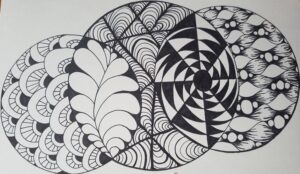Art is a naturally mindful process. Skills and training are not necessary to meditate through art. Children seem to naturally understand this process, but as people age they often become more critical and self-aware of their art processes and the act of mindful art, can be more difficult to achieve. But not impossible.
Something that I came across in my research on art and mindfulness practices is mindfulness-based art therapy (MBAT). This was new to me, and perhaps to you, so I will break it down.
MBAT-What is it?
Mindfulness-based art therapy combines the philosophy of mindfulness with the practice of art therapy. It is about engaging in the creative process of art as a means to explore yourself. MBAT is slowly being recognized as a tool for improvement in the field of psychology. It allows for connections between the body and feelings that may be hard to put into words. Art can include drama and music making as well.
Benefits of MBAT?
Mindfulness-based art therapy has been proven to help alleviate/or eliminate the symptoms of:
- anxiety disorders
- eating disorders
- substance abuse
- depressive disorders
- stress and anger-related issues
It has also been proven to affect:
- improved psychological stability
- improved quality of life
- reflecting a calm and focused state of attention
- reduced cognitive avoidance in which you become less aware of what you are thinking and doing when experiencing psychological distress
- improved intuition and trust in your own body (how you are feeling and what it means)
- increased emotional awareness
- increased sense of control and ability to share inner thoughts
- improved awareness of underlying issues that have been hidden
- ability to communicate abstract feelings
- increased self-esteem and self-acceptance
- improved attention span
The list of benefits is staggering and it left me wanting to know more. How can we implement art-based mindfulness into our lives and our students lives? And how often does one have to practice MBAT to experience positive results?
How Can It Be Practiced?
- Draw a picture of yourself-This can be a practice in self-reflection. We can be our own worst critics so it can be helpful to make the picture as realistic as possible (flaws and all).
- Mindfully study art materials/mediums-Taking the time to engage all of your senses as you work with different materials helps to bring focus to the moment.
- Use art to express emotions-When you are creating art try to express any, and all, emotions that arise. Displaying your emotions through art helps to identify unmet needs and acts as a medium of communication (particularly for young people who may not have the words to express their emotions).
- Collage-Use collage to help express interests, emotions and experiences.
- Art and walk-This is a fun one! Put paint on your feet and walk around on a large canvas or piece of paper. The senses will be engaged during this practice.
- Before and after-Take notice of your mental state before and after creating art. For students this could be achieved by guided reflection.
Research shows that as little as 1 hour/week of mindfulness based art therapy can achieve many of the psychological and physical benefits outlined above!
Below is a video I found on YouTube that guides you through a therapeutic art project. It can be done at home or in a classroom.
Here is a pic of one of the art projects I worked on this term. It is very similar to the activity above.

I love art. I have been participating in and observing artistic processes for as long as I can remember. Many of my family members (my Nana’s art is the cover of this post) and friends are artists and they too discuss the meditative qualities of their work. This term I am in an art class and it feels so good to learn new processes, practice what I am learning, and take the time out of my busy schedule to create. I am excited to implement mindfulness-based art therapy into my life, my children’s lives and my future classrooms!
Sources:
Cuncic, A. (2020). The Benefits of Mindfulness-Based Art Therapy. Retrieved from: https://www.verywellmind.com/mindfulness-based-art-therapy-4588189





